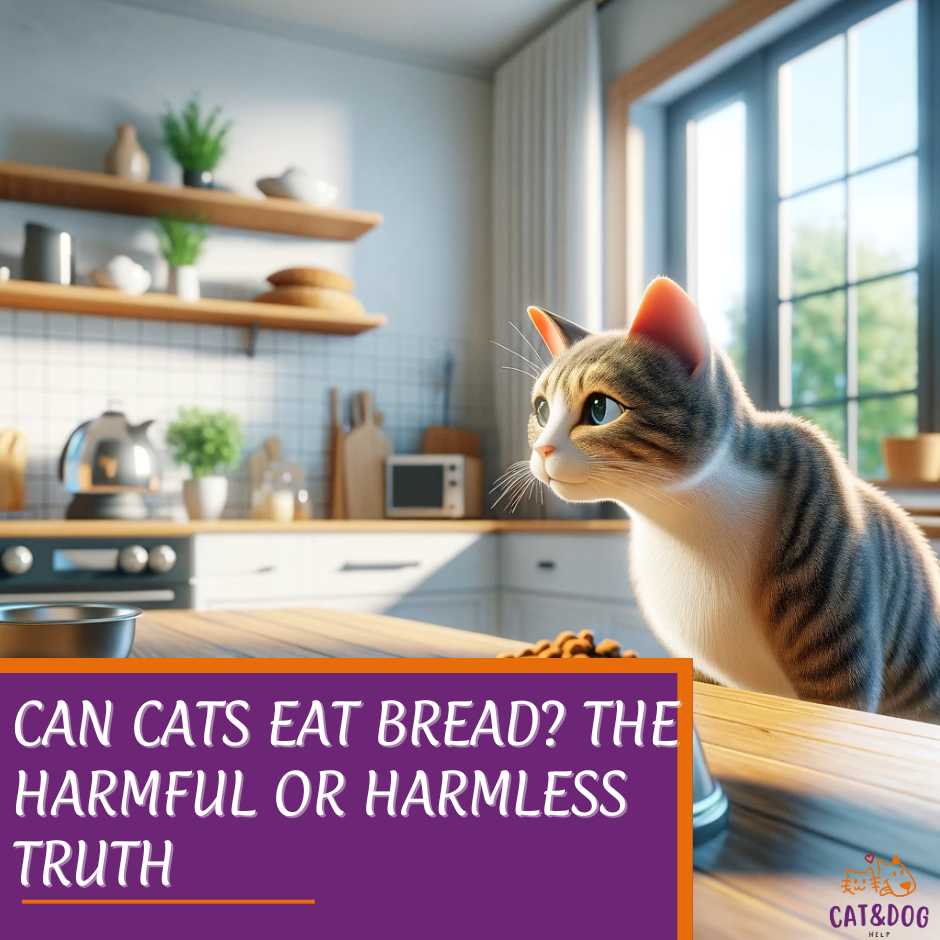When it comes to your cat’s nutrition, you may wonder which foods safe for humans are also safe for your feline friend.
As a responsible cat owner, you know that cats require a diet high in protein with the right balance of carbohydrates and fats, but what about those little extras you’re tempted to share from your plate?
Certainly, you can give your cat a small amount of bread as an occasional treat.
Recognizing what’s safe for your cat is crucial, especially when you’re pondering something common.
It’s always a good idea to consult your veterinarian before giving any human food to your cat.
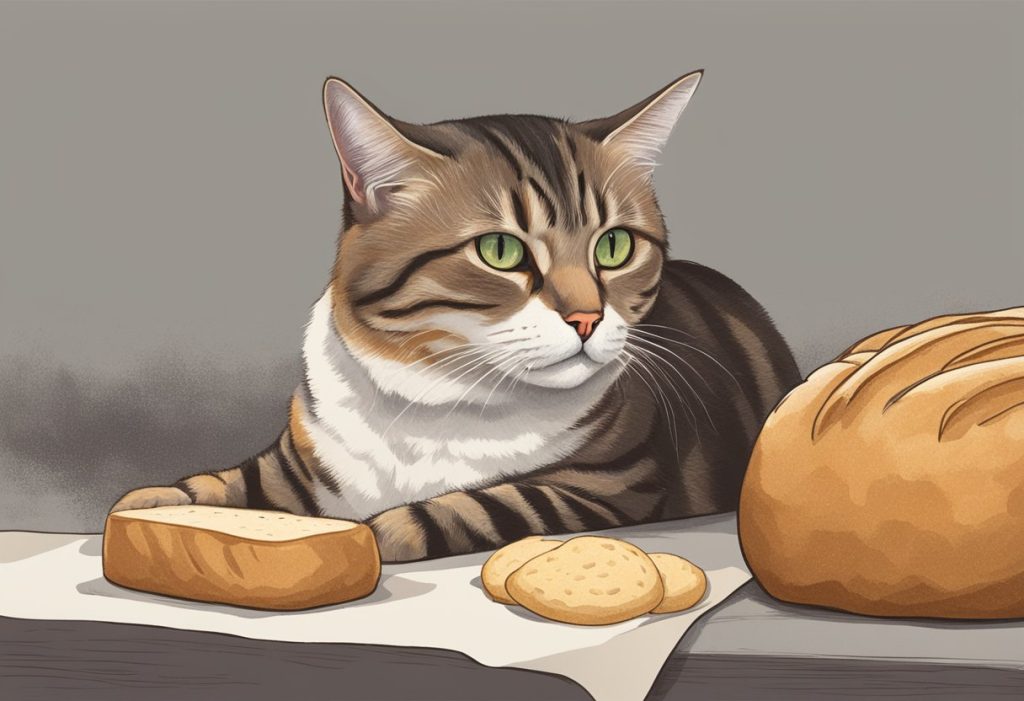
Bread is a staple in many households, and it’s not uncommon to think that sharing a small piece of plain bread, such as wheat bread, with your kitty could be a harmless tasty treat.
However, determining if bread is a suitable snack for cats demands a closer look at their dietary needs and the potential effects bread can have on their health.
While discussing alternative snacks for cats, it’s also important to understand why Spam isn’t good for your cat, just like bread, due to its high sodium and fat content that does not meet feline nutritional needs?
Understanding these details is key to ensuring that every treat you offer is both safe food and enjoyable for your purring pal.
Key Takeaways
- Cats require a diet high in protein, and bread does not offer the necessary nutrients cats need.
- While not toxic, bread should only be given to cats in moderation as an occasional treat.
- Responsible cat ownership includes knowing which human foods are safe as treats for cat and ensuring a balanced feline diet.
Can Cats Eat Bread? Understanding the Basics
Hey there, fellow cat lover! Have you ever caught your furry friend eyeing up that slice of bread you’re about to munch on?
You might be wondering, “Can my cat share this snack with me?” Let’s knead through the doughy details together, shall we?
Nutritional Value of Bread for Cats: Bread, as you know it, is chock-full of carbs, and we humans sure do love our carb-laden treats. But let’s talk about your whiskered companion’s nutritional needs. (1)
Cats are obligate carnivores, which means their bodies are fine-tuned to digest and utilize proteins and fats from meat—not carbohydrates from bread or other animal products. (2)
Feeding your cat high-quality cat food that’s been recommended by their vet is the best way to ensure they are getting all the nutrients they need, including meat-based protein and amino acids.
Bread offers no health benefits to cats.
So, what does this mean? Bread doesn’t provide your kitty with crucial taurine, arachidonic acid, or vitamin A, which they typically derive from animal sources. (3)
A slice of bread here and there isn’t going to fill their tank with what they truly need. Think of bread as those empty calories that sometimes sneak into your diet — tasty but not particularly useful.
Potential Risks and Considerations: Now, if curiosity gets the better of your cat and they sneak a bite, don’t fret — a nibble won’t hurt.
However, regularly treating your cat to bread could lead to more than just an adorable cat belly.
- Unleavened vs. Leavened Bread: The former, a flatbread without yeast, is less risky, while regular leavened bread can cause digestive issues.
- Raw Dough Alert: A no-go! Raw dough expands inside the stomach, leading to pain and potentially serious bloating.
- Toppings and More: Garlic bread, raisin bread, or anything slathered in butter or oil? That’s triple trouble with potential toxicities and pancreatitis risks.
In summary, as tempting as it is to share every moment (and morsel) with your furball, it’s best to stick to foods that cater to their carnivorous lifestyle.
A balanced cat food formulated just for them is the way to go to keep that purr motor running smoothly. Remember, you’re the gatekeeper to your cat’s diet, so make those choices count!
Expert Insights on Bread as a Cat Food
Have you ever caught your furry friend eyeing your toast? You may wonder, “Can my cat safely munch on a bit of bread?” Let’s knead through the facts.
What Veterinarians Say: Veterinary professionals generally consider bread to be non-toxic to cats. However, as a general rule, they don’t recommend it as a dietary staple.
A snippet of insight from them would be, “For cats, bread is a source of empty calories and should not be a regular part of a cat’s diet.”
Just one slice of white bread can contain a fifth of the daily caloric needs of the average cat.
And watch out for uncooked dough – it’s a no-go since it can expand in the stomach, potentially leading to severe bloating or even the need for surgical intervention if consumed in large quantities.
It’s important to be aware of toxic foods for cats, and bread flavored with tomato, onion, or garlic should be considered one of them.
So, if you’re tempted to share your sandwich, remember that moderation is key. A tiny crumb now and then won’t harm, but bread should never replace a portion of a cat’s balanced diet.
Alternative Healthy Snacks for Cats: Cats are obligate carnivores, so let’s talk about treats that will make their hearts purr and keep their diet on track. Here are some paw-some alternatives:
- Cooked Meat: Think chicken or turkey – just ensure it’s plain and boneless.
- Fish: Occasionally, a bit of salmon or tuna can be a treat, but beware of bones and don’t overdo it.
- Catnip or Cat Grass: A pinch of these can be both entertaining and safe for your kitty.
Remember, while sharing food with your cat may feel like a bonding moment, it’s vital to prioritize their health with species-appropriate treats.
Trust me, they’ll love you just the same, probably, even more, when they’re feeling their best!
In-Depth Analysis of Alternative Nutritional Options for Cats
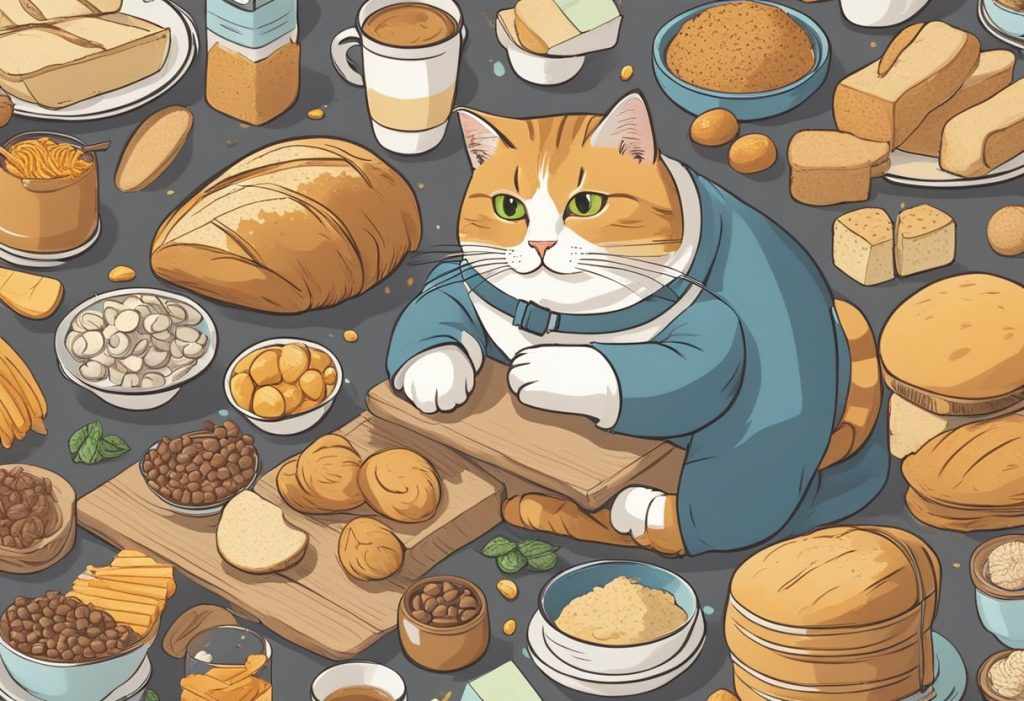
Hey there, cat lover! You might be wondering if there’s anything besides the traditional kibble that your furry friend can munch on, right?
While your cat’s gaze might tempt you to share your bread, there are far better choices out there. Let’s munch on some knowledge about what alternative snacks can boost your cat’s health.
Healthy Snacks in Disguise
Felines are carnivores at heart, so high-protein snacks are the way to go. Here’s a trove of treasures you can offer instead of bread:
- Cooked Meat: Think chicken or turkey—sans the seasoning of course!
- Fish: A sliver of cooked salmon or tuna can make their day (and yours seeing their happy dance).
Remember, these should be occasional treats, not the main course.
Vegetable Sidekicks
Just like side dishes complement your meal, veggies can be a great addition, in tiny amounts, to your cat’s diet:
- Steamed Carrots: Sliced and soft, these are like orange gold nuggets for your cat’s health.
- Green Beans: Another veggie to bring a splash of green and fiber to the table.
Keep it sparse and simple; cats’ tummies are sensitive!
Grain Brain
While bread is a no-go, small amounts of these grains can be okay:
- Cooked Rice: White or brown, it’s a safe filler when your cat needs something extra.
- Barley: Cooked and in small doses, it’s a palatable choice for most kitties.
The Golden Ratio
Curious about adding human foods to your cat’s feast? Here’s a golden nugget for you: 90/10 is the magic ratio—90% high-quality cat food, with treats being no more than 10% of their diet.
To make sure they’re getting the nutrients they need, always prioritize commercial cat food designed for their specific life stage and health needs.
Strike a balance, keep it safe, and your kitty will be both happy and healthy! Now that’s something to purr about, isn’t it?
Responsible Cat Ownership and Feeding Practices
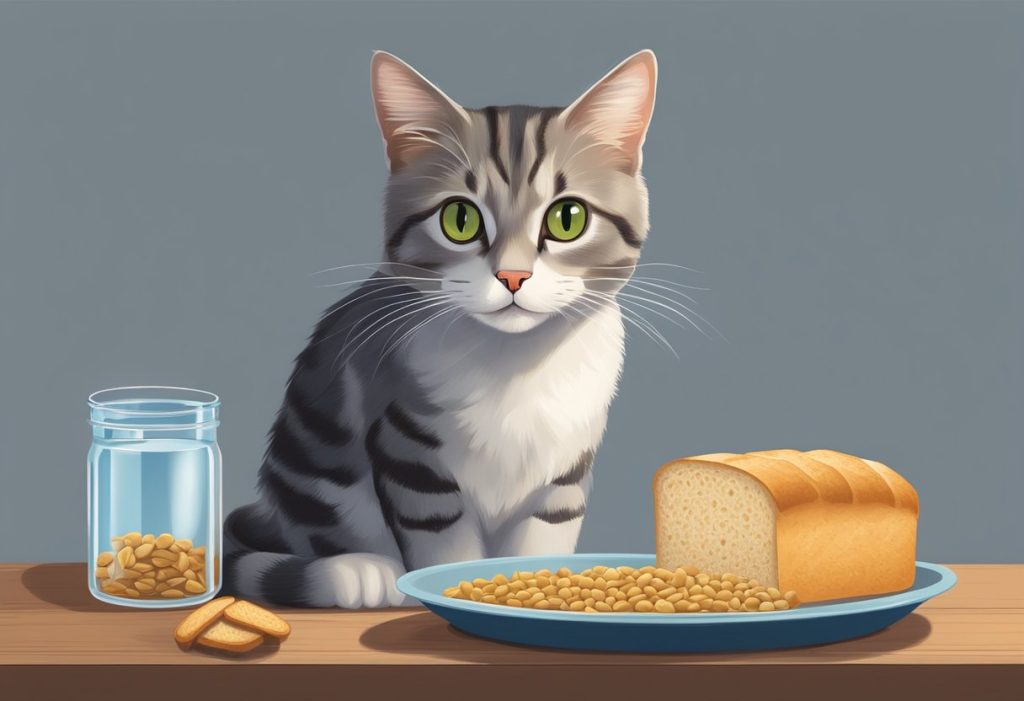
Are you looking at that loaf of bread and wondering if sharing a slice with your feline friend is okay? Let’s knead through the facts! Bread isn’t toxic to cats, but it’s not the most nutritious snack for them either.
Portion Control and Frequency:
Before you let your kitty chow down on some sourdough, let’s talk portion size! Just like treats for humans, less is more. Here’s a crumb of advice:
- A tiny cube (about the size of a dice) is plenty!
- Making this an occasional treat—think once a week—is purr-fect.
While occasional treats can be a fun way to spoil your cat, practicing moderation in your cat’s diet is crucial to avoid health issues related to overindulgence
Remember, moderation is key! Too much bread can contribute to unwanted weight gain and other health issues.
Identifying Allergic Reactions:
Just like us, cats can have allergic reactions too. Keep an eye open for signs like:
If you spot any of these symptoms after your kitty has sampled some bread, it’s time to contact your vet. They’re like the Sherlock Holmes of pet health, ready to deduce what’s up with your feline!
So there you have it, some food for thought before you give into those begging kitty eyes. Keep treats like bread to a minimum and monitor your cat for any odd reactions.
Now, go enjoy your carb fest together – responsibly, of course!
Quick Recap
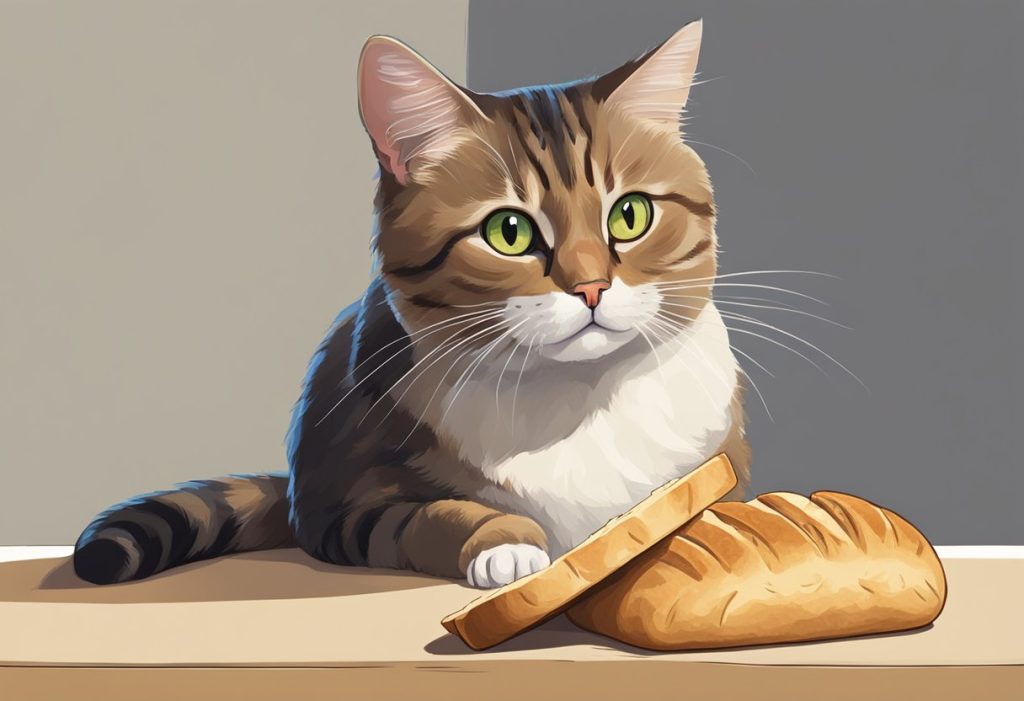
Can Your Cat Have Bread As a Treat? Yes, bread can be offered to your cat, but only in very small quantities.
Think of it as an occasional indulgence rather than a regular part of your cat’s diet.
Why? Because cats are obligate carnivores, which means their bodies are fine-tuned to process meat, not grains.
Pet parents should focus on more appropriate meat-based treats, including new food, for their healthy cat. However, it’s important to note that feeding bread to cats can potentially cause gastrointestinal issues.
Main Takeaways:
- Safety: Bread is not toxic to cats.
- Moderation: Only offer bread as a rare treat.
- Nutritional Value: Bread doesn’t offer the nutritional elements that cats require.
Bread Types and Concerns:
- Yeasted Bread: Avoid it. Uncooked dough can expand in a cat’s stomach, causing discomfort or even an emergency.
- Added Ingredients: Be cautious of bread with garlic, onions, poppy seeds, or raisins, which are toxic to cats.
Special Considerations: If your furry pal has any dietary restrictions or sensitivities, bread might be a no-go.
Cats with conditions like diabetes or obesity should be given treats that are both safe and beneficial for their health. Always consult with your vet for personalized advice.
How to Serve:
- Small Pieces: If you do decide to give your cat bread, tiny bits are sufficient.
- Occasionally: Reserve this treat for rare occasions to avoid digestive issues.
Remember, each cat is unique – what might be harmless for one might not be suitable for another. Play it safe, keep your vet in the loop, and your kitty will thank you with delightful purrs of contentment.
Frequently Asked Questions
When it comes to sharing your bread with your cat, you may have a few questions. Can they handle it? How much is okay? Let’s tackle these bread-based puzzlers together!
Can Kittens Eat Bread Safely?
You might think that what’s safe for an adult cat must be safe for a kitten, right?
Not quite. Kittens have delicate digestive systems and introducing bread to their diet isn’t recommended.
Stick to kitten-formulated food to ensure they get the nutrients they need.
How Much Bread Can a Cat Eat Without Health Risks?
Less is more here. While a small piece of bread won’t generally hurt your cat, it shouldn’t replace their regular diet.
Treat bread like a treat—occasionally and in tiny amounts.
Are there any specific parts of bread that cats should avoid?
Indeed, the crust might seem harmless, but it’s best to err on the side of caution.
The crust can be harder to digest for some cats, and those extra carbs aren’t necessary for their diet.
Are There Any Bread Ingredients That Are Toxic to Cats?
Watch out for garlic, onions, and raisins—these common bread additives can be toxic to cats. Always check the ingredient list before sharing a bite.
Can Cats with Diabetes Eat Bread?
If your furball has diabetes, bread should likely be off the menu. The high carbohydrate content can affect their blood sugar levels, so it’s best to avoid it.
Will Eating Bread Cause Weight Gain in Cats?
Cats need protein, not carbs. Too much bread can lead to a chunkier kitty due to its high-calorie count and minimal nutritional benefit for cats.
Could Bread Cause Allergies in Cats?
Although not common, allergies can occur. If you notice any odd reactions after your cat nibbles on bread, it’s probably best to skip the bakery treats for your whiskered friend.

